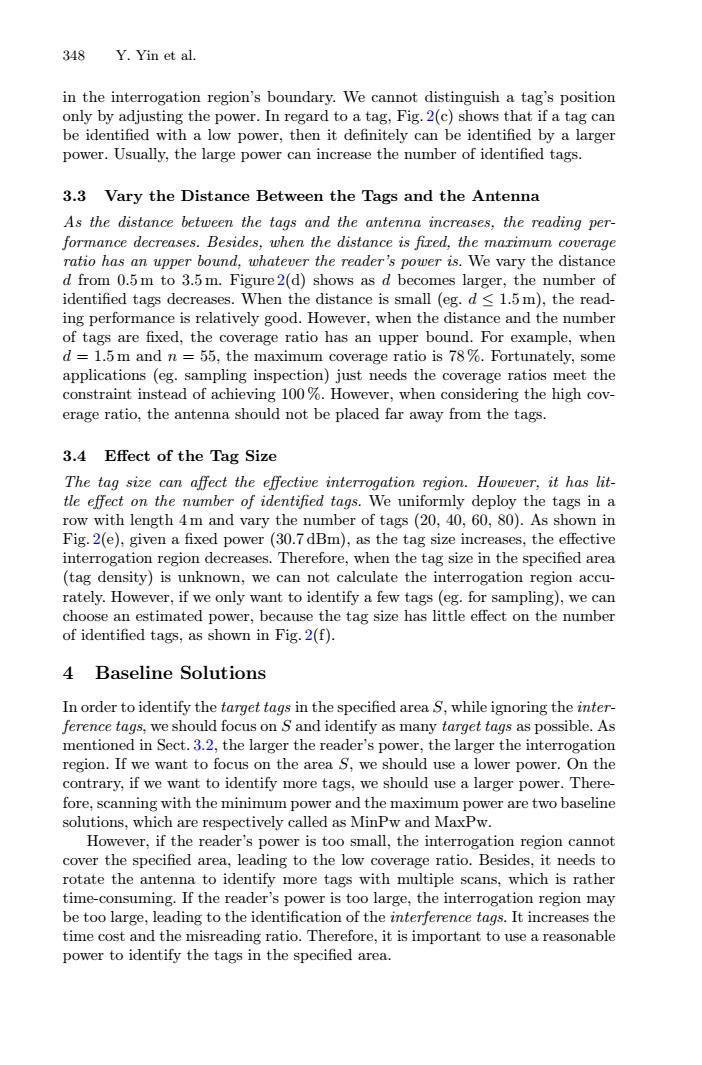正在加载图片...

348 Y.Yin et al. in the interrogation region's boundary.We cannot distinguish a tag's position only by adjusting the power.In regard to a tag,Fig.2(c)shows that if a tag can be identified with a low power,then it definitely can be identified by a larger power.Usually,the large power can increase the number of identified tags. 3.3 Vary the Distance Between the Tags and the Antenna As the distance between the tags and the antenna increases,the reading per- formance decreases.Besides,when the distance is fired,the marimum coverage ratio has an upper bound,whatever the reader's power is.We vary the distance d from 0.5m to 3.5m.Figure2(d)shows as d becomes larger,the number of identified tags decreases.When the distance is small (eg.d<1.5m),the read- ing performance is relatively good.However,when the distance and the number of tags are fixed,the coverage ratio has an upper bound.For example,when d =1.5m and n =55,the maximum coverage ratio is 78%.Fortunately,some applications (eg.sampling inspection)just needs the coverage ratios meet the constraint instead of achieving 100 %However,when considering the high cov- erage ratio,the antenna should not be placed far away from the tags. 3.4 Effect of the Tag Size The tag size can affect the effective interrogation region.However,it has lit- tle effect on the number of identified tags.We uniformly deploy the tags in a row with length 4m and vary the number of tags (20,40,60,80).As shown in Fig.2(e),given a fixed power (30.7dBm),as the tag size increases,the effective interrogation region decreases.Therefore,when the tag size in the specified area (tag density)is unknown,we can not calculate the interrogation region accu- rately.However,if we only want to identify a few tags (eg.for sampling),we can choose an estimated power,because the tag size has little effect on the number of identified tags,as shown in Fig.2(f). 4 Baseline Solutions In order to identify the target tags in the specified area S,while ignoring the inter- ference tags,we should focus on S and identify as many target tags as possible.As mentioned in Sect.3.2,the larger the reader's power,the larger the interrogation region.If we want to focus on the area S,we should use a lower power.On the contrary,if we want to identify more tags,we should use a larger power.There- fore,scanning with the minimum power and the maximum power are two baseline solutions,which are respectively called as MinPw and MaxPw. However,if the reader's power is too small,the interrogation region cannot cover the specified area,leading to the low coverage ratio.Besides,it needs to rotate the antenna to identify more tags with multiple scans,which is rather time-consuming.If the reader's power is too large,the interrogation region may be too large,leading to the identification of the interference tags.It increases the time cost and the misreading ratio.Therefore,it is important to use a reasonable power to identify the tags in the specified area.348 Y. Yin et al. in the interrogation region’s boundary. We cannot distinguish a tag’s position only by adjusting the power. In regard to a tag, Fig. 2(c) shows that if a tag can be identified with a low power, then it definitely can be identified by a larger power. Usually, the large power can increase the number of identified tags. 3.3 Vary the Distance Between the Tags and the Antenna As the distance between the tags and the antenna increases, the reading performance decreases. Besides, when the distance is fixed, the maximum coverage ratio has an upper bound, whatever the reader’s power is. We vary the distance d from 0.5 m to 3.5 m. Figure 2(d) shows as d becomes larger, the number of identified tags decreases. When the distance is small (eg. d ≤ 1.5 m), the reading performance is relatively good. However, when the distance and the number of tags are fixed, the coverage ratio has an upper bound. For example, when d = 1.5 m and n = 55, the maximum coverage ratio is 78 %. Fortunately, some applications (eg. sampling inspection) just needs the coverage ratios meet the constraint instead of achieving 100 %. However, when considering the high coverage ratio, the antenna should not be placed far away from the tags. 3.4 Effect of the Tag Size The tag size can affect the effective interrogation region. However, it has little effect on the number of identified tags. We uniformly deploy the tags in a row with length 4 m and vary the number of tags (20, 40, 60, 80). As shown in Fig. 2(e), given a fixed power (30.7 dBm), as the tag size increases, the effective interrogation region decreases. Therefore, when the tag size in the specified area (tag density) is unknown, we can not calculate the interrogation region accurately. However, if we only want to identify a few tags (eg. for sampling), we can choose an estimated power, because the tag size has little effect on the number of identified tags, as shown in Fig. 2(f). 4 Baseline Solutions In order to identify the target tags in the specified area S, while ignoring the interference tags, we should focus on S and identify as many target tags as possible. As mentioned in Sect. 3.2, the larger the reader’s power, the larger the interrogation region. If we want to focus on the area S, we should use a lower power. On the contrary, if we want to identify more tags, we should use a larger power. Therefore, scanning with the minimum power and the maximum power are two baseline solutions, which are respectively called as MinPw and MaxPw. However, if the reader’s power is too small, the interrogation region cannot cover the specified area, leading to the low coverage ratio. Besides, it needs to rotate the antenna to identify more tags with multiple scans, which is rather time-consuming. If the reader’s power is too large, the interrogation region may be too large, leading to the identification of the interference tags. It increases the time cost and the misreading ratio. Therefore, it is important to use a reasonable power to identify the tags in the specified area